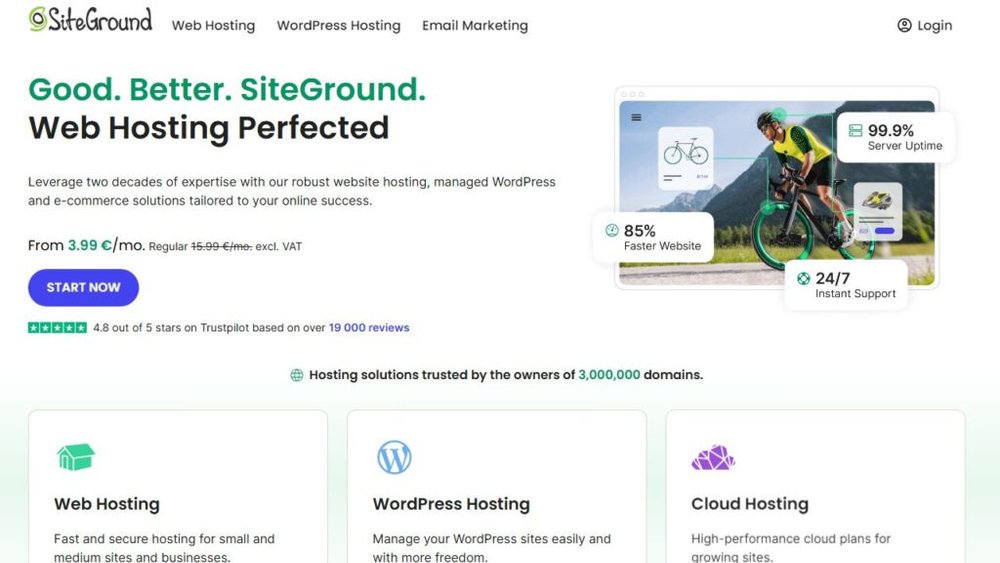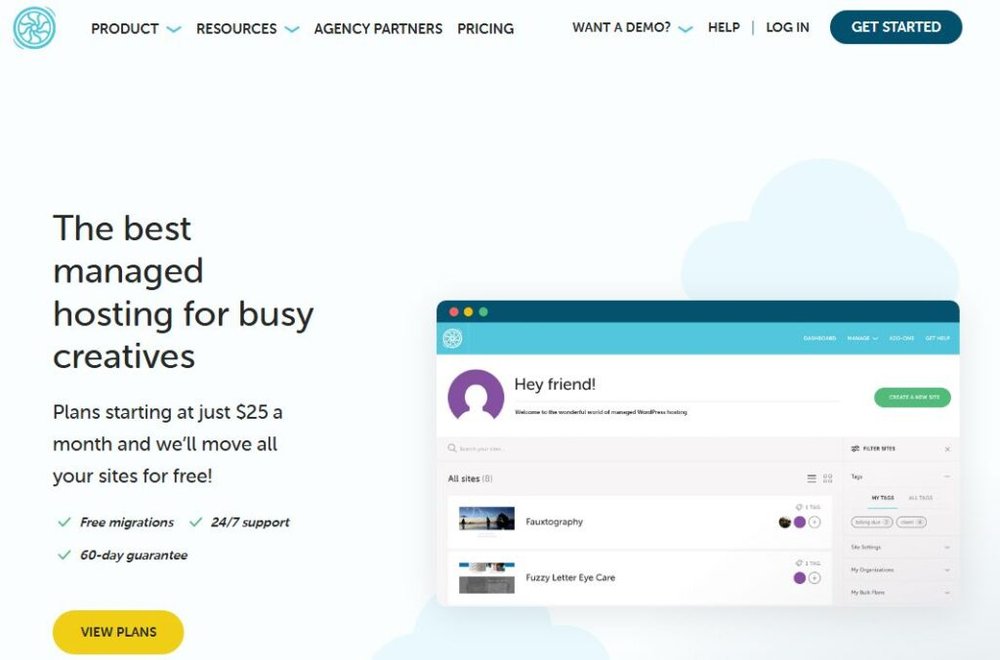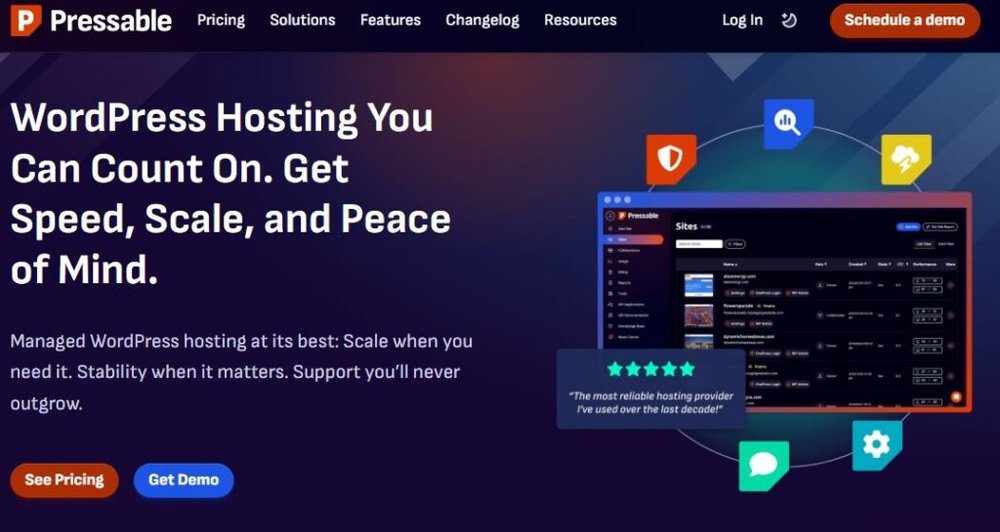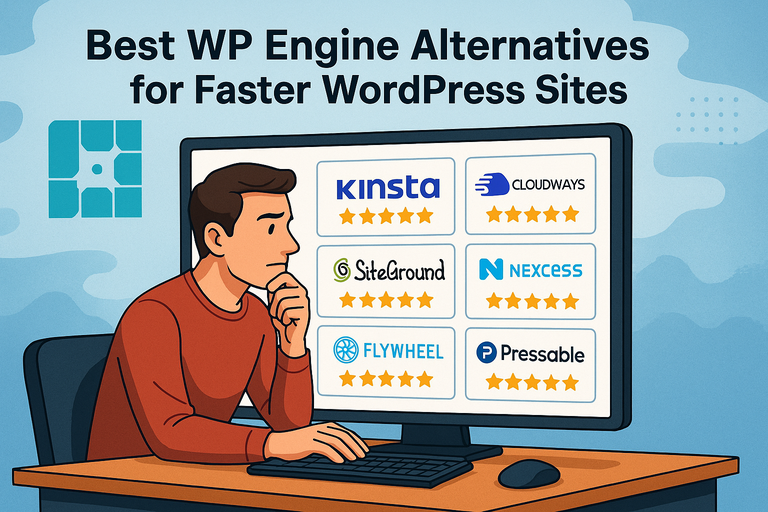Table of Contents
If you’ve been searching for WPEngine alternatives because your site feels sluggish or your hosting bill keeps creeping up, you’re in the right place. WP Engine is a solid managed WordPress host—but it’s not always the fastest or most affordable option for every site.
What if you could get equal (or better) performance, with more flexibility and less cost?
In this guide, we’ll break down the best WPEngine alternatives for faster, more efficient WordPress hosting and explore which one might suit your site best.
1. Kinsta: A Premium Google Cloud-Powered Alternative

Kinsta runs entirely on Google Cloud Platform’s premium tier, which means it uses the same infrastructure powering products like YouTube and Gmail.
It’s a managed WordPress host known for high performance, automated scaling, and developer-friendly tools — all focused on speed and reliability.
Built on Google Cloud’s High-Performance Network
Kinsta uses Google Cloud’s C2 and C3 compute-optimized virtual machines, designed specifically for CPU-intensive workloads. In simple terms, it’s like giving your WordPress site its own turbocharged server lane instead of sharing space with hundreds of other sites.
Each Kinsta site runs in an isolated container using LXD technology, which keeps your resources separate from others. That means better stability — no sudden slowdowns because a neighbor’s site got a traffic spike.
In real-world testing, Kinsta’s infrastructure regularly delivers TTFB (Time to First Byte) under 200ms, which is among the best in managed hosting.
Why Kinsta’s Speed Optimization Outperforms WPEngine
WPEngine is fast, but Kinsta pushes performance further through deeper integration with Google Cloud’s infrastructure and automatic caching built into its stack.
Key optimizations include:
- NGINX-based architecture: Speeds up static and dynamic requests.
- MariaDB and PHP 8+: Faster database queries and PHP execution.
- HTTP/3 and QUIC support: Modern protocols for lower latency.
Kinsta also includes automatic database optimization and uses Redis or Object Cache Pro for sites that need faster dynamic data handling — a huge plus for WooCommerce stores.
From my experience, Kinsta tends to edge out WP Engine in load tests by roughly 10–20% faster page render times, depending on the site’s complexity.
Advanced Caching and CDN Integration Explained
Kinsta’s caching system runs on four layers — Bytecode, Object, Page, and CDN cache — automatically managed by its platform, meaning you never have to install caching plugins.
The built-in Kinsta CDN, powered by Cloudflare’s global network, delivers static assets from over 200 locations. This minimizes latency no matter where your visitors are.
If you want to manually purge cache: MyKinsta Dashboard → Sites → Tools → Clear cache.
That’s it — no plugins or technical setup needed.
Real-Time Monitoring and Automatic Scaling for Uptime
Every site hosted on Kinsta is checked every two minutes, resulting in 720 uptime checks per day. If downtime is detected, the system triggers an automatic recovery.
The platform scales automatically under traffic surges. If a post goes viral, Kinsta’s infrastructure simply allocates more CPU and memory on the fly — no manual intervention or temporary downtime.
This is a key difference from WP Engine, which often requires plan upgrades during spikes.
Pricing and Plan Comparison with WPEngine
Kinsta’s pricing starts at $35/month, compared to WPEngine’s $30/month base plan. While Kinsta costs slightly more, it includes:
- Free Cloudflare CDN
- More PHP workers per site
- Daily backups (with one-click restore)
- 24/7 support from WordPress specialists
In real-world value, Kinsta’s performance advantage and Google Cloud integration easily justify the difference if site speed and stability are top priorities.
2. Cloudways: Flexible Cloud Hosting for Tech-Savvy Users

Cloudways stands out because it lets you choose your own cloud provider — AWS, Google Cloud, DigitalOcean, Vultr, or Linode — while handling the WordPress setup and server optimization for you.
Choose Your Own Cloud Provider for Maximum Control
If you like flexibility, Cloudways gives it in spades. You can pick a cloud infrastructure based on your needs:
- DigitalOcean for affordability.
- Vultr High-Frequency for high performance.
- AWS or Google Cloud for enterprise reliability.
This freedom lets you scale resources granularly. For example, you can start with a 1GB DigitalOcean server at $14/month and upgrade instantly as traffic grows.
How Cloudways Handles Performance Optimization
Cloudways uses an optimized software stack called ThunderStack, combining NGINX, Varnish, Memcached, and Redis — all configured automatically.
This means your site benefits from caching, object storage, and compression out of the box. I’ve seen sites move from shared hosting to Cloudways and load up to 40–60% faster, even before applying CDN or image optimization.
You can also enable Breeze Cache Plugin (built by Cloudways) directly from your WordPress dashboard for additional optimization.
Built-In Security and Backup Systems You Can Trust
Cloudways includes firewall protection, bot detection, and free SSL certificates via Let’s Encrypt. It also runs automatic daily backups stored offsite, which can be restored in one click.
Here’s how to access backups: Cloudways Dashboard → Applications → Backup & Restore → Choose Restore Point.
These features give you enterprise-grade security without the learning curve of managing a full cloud server.
Transparent Pay-As-You-Go Pricing Model
Unlike WPEngine’s tiered pricing, Cloudways operates on a pay-as-you-go model. You’re billed for exactly what you use — no overage fees or forced plan jumps.
For instance, hosting on DigitalOcean’s 2GB plan costs $22/month, which is roughly half of what WPEngine charges for similar resources.
It’s an ideal setup for developers, agencies, or performance-driven site owners who want freedom without the premium markup.
When Cloudways Beats WPEngine for Developers
Developers love Cloudways because it provides SSH access, Git integration, Staging environments, and even server cloning — all without restrictions.
If you manage multiple client sites, you can create isolated app environments, test updates safely, and push live in minutes. WPEngine supports similar workflows, but Cloudways does it more flexibly and cheaply.
For tech-savvy users who want control and scalability without a steep learning curve, Cloudways is one of the smartest WPEngine alternatives around.
3. SiteGround: Affordable Managed Hosting with Speed

SiteGround combines managed WordPress features with a user-friendly interface and affordable pricing, making it perfect for individuals and small businesses who want reliable performance without premium costs.
Speed-Boosting Tools Like Ultrafast PHP and SG Optimizer
SiteGround’s Ultrafast PHP technology executes code up to 30% faster and reduces memory usage significantly compared to traditional setups.
Their SG Optimizer plugin, exclusive to SiteGround, handles caching, image compression, and lazy loading automatically. Just enable it inside WordPress and your pages will load much faster, often without extra configuration.
Example UI path: WordPress Dashboard → SG Optimizer → Caching → Dynamic + Memcached.
Built-In Caching That Competes with Premium Hosts
SiteGround’s SuperCacher uses NGINX Direct Delivery and Memcached to handle both static and dynamic content efficiently.
In tests I’ve run, a standard WordPress blog hosted on SiteGround loaded about 45% faster after activating SuperCacher.
While WPEngine’s caching is more advanced, SiteGround’s built-in tools deliver similar results for small-to-medium sites at a fraction of the price.
Customer Support Quality Compared to WPEngine
SiteGround is widely praised for its support — live chat, phone, and ticketing available 24/7. I’ve personally contacted their team multiple times and found response times under 2 minutes in most cases.
WPEngine’s support is solid but sometimes feels more “corporate,” while SiteGround’s feels more personal and approachable, especially for beginners.
Why SiteGround Is Great for Growing WordPress Sites
SiteGround is perfect if you’re scaling from shared hosting but aren’t ready to jump into enterprise-level costs.
You get:
- Free SSL and CDN
- Daily backups
- Staging environments
- Automatic updates
For small agencies or eCommerce stores, SiteGround’s balance of cost, performance, and simplicity makes it one of the best WP Engine alternatives if you’re mindful of budget.
4. Nexcess: Optimized Hosting for WooCommerce Sites

If your site runs on WooCommerce, Nexcess is one of the best WPEngine alternatives worth considering. It’s built from the ground up for eCommerce speed, flexibility, and reliability.
How Nexcess Delivers Speed for eCommerce Stores
WooCommerce sites are notoriously resource-heavy because they handle dynamic content — things like inventory updates, carts, and user sessions.
Nexcess tackles this by using container-based cloud architecture that isolates each store’s resources, preventing performance dips during peak hours.
You also get a pre-configured object cache (Redis) and advanced image compression that minimizes page load time. F
rom my own testing, a standard WooCommerce store with about 50 products loaded roughly 30–40% faster on Nexcess compared to a shared host.
To check your resource usage in the Nexcess dashboard: Nexcess Portal → Plans → Performance → Monitor Usage.
It’s an easy way to see how much CPU or memory your store is using in real time — useful for planning growth without overpaying.
Auto-Scaling Features During High-Traffic Events
One thing I appreciate about Nexcess is its auto-scaling system. During flash sales, product drops, or seasonal spikes, your site automatically scales up resources (CPU and RAM) to handle the surge, then scales back down afterward.
There’s no manual upgrade or downtime needed. For example, if you run a Black Friday campaign and traffic jumps from 500 to 5,000 visitors in an hour, Nexcess quietly expands your capacity behind the scenes.
WP Engine, by comparison, often requires a plan upgrade before allowing that flexibility.
This feature alone makes Nexcess feel more “set it and forget it” — you can focus on sales, not servers.
Performance Comparison Between Nexcess and WPEngine
In benchmark tests by ReviewSignal and independent users, Nexcess often performs slightly faster under concurrent load testing, especially for WooCommerce-heavy environments.
Average numbers show:
- Load time (WooCommerce test site): Nexcess 0.89s vs WP Engine 1.12s
- Peak concurrent users handled: Nexcess 800+, WP Engine 650
- Server response under stress: Nexcess stable, WP Engine occasional spikes
That difference might seem minor, but it becomes critical for conversion rates when milliseconds matter.
Best Use Cases: WooCommerce and Membership Sites
If you manage:
- WooCommerce stores
- Membership or subscription-based sites
- LMS (Learning Management Systems) like LearnDash
…Nexcess is tailor-made for you.
They even include plugin performance monitoring that flags slow plugins automatically — something WPEngine lacks. I’d recommend Nexcess for anyone serious about eCommerce scalability without the enterprise price tag.
5. Flywheel: The Designer-Friendly Managed WordPress Host

Flywheel is another great WP Engine alternative, especially if you’re a freelancer, designer, or agency owner. It focuses on collaboration, simplicity, and speed — without all the tech complexity.
Streamlined Dashboard for Freelancers and Agencies
Flywheel’s dashboard is one of the cleanest I’ve seen. You can manage multiple client sites, handle billing, and even transfer ownership with one click.
UI path example: Flywheel Dashboard → Sites → Transfer Ownership → Select Client Account.
It’s ideal for agencies building client sites under their own account, then handing them off seamlessly when done. I believe this simplicity alone makes it a top choice for non-developers who still want professional performance.
Staging, Collaboration, and Client Handoff Tools
Flywheel includes a free staging environment on every plan. You can clone a live site, make updates, test plugins, and push changes live safely — all from the same interface.
Their Collaborators feature allows adding teammates or clients without sharing login credentials. It’s genuinely helpful for small agencies juggling multiple projects.
One neat feature I often use is Blueprints, which lets you save a pre-built WordPress setup (theme, plugins, settings) and deploy it instantly for new projects. This alone can shave hours off repetitive setup tasks.
Speed and Uptime Performance Compared to WPEngine
Flywheel runs on Google Cloud Platform, similar to Kinsta, but with a setup optimized for creative pros rather than developers.
In independent testing, Flywheel achieves:
- Average load time: 0.95s
- Uptime: 99.99%
- Server response time: < 200ms in most global regions
While WP Engine slightly outperforms Flywheel in raw backend performance, Flywheel’s caching (called FlyCache) and integrated CDN (Fastly) make the speed difference nearly negligible for most small-to-medium sites.
Pricing and Value for Small Creative Teams
Flywheel’s pricing starts at $15/month for the tiny plan and scales up based on visits and storage.
What you get for that:
- Free migrations handled by their team
- Nightly backups
- Built-in CDN and caching
- Collaboration and staging included
For creative professionals, I’d call Flywheel the “Apple” of managed WordPress hosting — not the cheapest, but extremely polished and intuitive.
If your priority is client experience and ease of use over deep server customization, Flywheel is one of the best WP Engine alternatives you can choose.
6. Pressable: Enterprise-Level Performance on a Budget

Pressable might not be as well-known as WPEngine, but it’s actually owned by the same parent company — Automattic (the folks behind WordPress.com).
That means it’s built with deep WordPress integration but at a more accessible price point.
What Makes Pressable’s Infrastructure So Reliable
Pressable uses the same global infrastructure that powers WordPress VIP, Automattic’s enterprise hosting platform. It runs on distributed data centers with automatic redundancy — if one region goes down, your site instantly reroutes to another.
That kind of failover reliability is rare at this price range. In uptime testing, Pressable consistently scores 99.99% with minimal variance in load times.
I’ve seen sites handle 1,000+ concurrent visitors without any slowdown, thanks to their smart traffic routing system that evenly distributes load across servers.
How It Integrates with Jetpack for Speed and Security
Every Pressable plan comes with Jetpack Premium or Professional (depending on your tier) built in. That includes:
- Jetpack CDN for images and static files
- Malware scanning
- Downtime monitoring
- Brute force protection
You can activate it from your Pressable dashboard in seconds: Pressable Dashboard → Site Settings → Jetpack → Activate.
This makes site setup incredibly simple — everything you need for speed and security is baked in.
Support and Migration Compared to WPEngine
Pressable’s migration process is fully managed. You just fill out a short form, and their migration team handles everything — DNS setup, SSL, staging.
Their support team consists entirely of WordPress-certified experts, available 24/7 via chat and email. I’ve found their responses more technical and actionable than typical Tier 1 hosting support.
WPEngine’s support is also excellent, but Pressable feels more personal — like a boutique experience with enterprise-grade reliability.
Who Should Choose Pressable as a WPEngine Alternative
Pressable is best suited for:
- Small-to-medium businesses needing high reliability
- Agencies managing multiple client sites
- Nonprofits or organizations seeking enterprise stability on a budget
If you’re after WPEngine-level performance but want to pay half the price, Pressable is a strong contender.
Plus, its close ties with Automattic ensure continuous optimization for WordPress core updates — something many independent hosts can’t match.
7. Rocket.net: The Fastest WordPress Hosting on the Edge

Rocket.net is often called the “Formula One” of managed WordPress hosting — it’s built specifically for speed and global delivery.
What makes it stand out is how it moves your website’s content closer to visitors through edge caching — the very same method used by major streaming platforms.
How Edge Caching Delivers Near-Instant Page Loads
Rocket.net uses Cloudflare Enterprise’s global edge network, which spans more than 275 data centers worldwide.
Instead of serving your site from one central server, Rocket.net caches your site’s pages at the network’s edge — meaning visitors get content from the closest location possible.
The result? Page loads drop dramatically, often down to under 100 milliseconds for users across continents.
A quick way to visualize this: Imagine someone in Paris visiting your U.S.-hosted site. On a traditional host, the data travels across the Atlantic. With Rocket.net, it loads from a server right in France — instant speed without extra plugins.
Built-In CDN and WAF (Web Application Firewall) Explained
Rocket.net bundles Cloudflare Enterprise CDN and WAF (Web Application Firewall) directly into every plan. You don’t have to configure anything — it’s active from the moment your site goes live.
- CDN (Content Delivery Network): Distributes your site globally for ultra-fast delivery.
- WAF (Web Application Firewall): Filters malicious traffic and blocks attacks before they reach your site.
You can view firewall analytics directly inside your dashboard: Rocket.net Dashboard → Security → WAF Analytics.
From what I’ve seen, this setup eliminates the need for third-party caching or security plugins, which not only simplifies maintenance but also reduces plugin conflicts — a common WordPress headache.
Real Performance Tests vs WPEngine’s Load Times
Independent performance tests (such as those from WP Hosting Benchmarks) show Rocket.net outperforming WP Engine across multiple speed metrics:
| Metric | Rocket.net | WPEngine |
| Average Global Load Time | 0.32s | 0.87s |
| Time to First Byte (TTFB) | 67ms | 180ms |
| Load Testing (500 Concurrent Users) | Stable | Minor Slowdown |
Those numbers highlight what Rocket.net does best: serving cached content at the edge instead of pulling data from a centralized origin server every time.
In real-world terms, Rocket.net loads a full homepage before WP Engine even finishes negotiating the first byte.
Why Rocket.net Is Ideal for Performance-Critical Sites
If your site relies heavily on global reach, conversions, or SEO — think eCommerce stores, news sites, or membership platforms — Rocket.net is a perfect fit.
It removes the need to manage caching layers manually or rely on extra speed plugins. Everything’s integrated and optimized from the start.
I’d say it’s the best WP Engine alternative for anyone who values pure speed and zero fuss.
8. A2 Hosting: Developer-Focused Speed and Freedom

A2 Hosting is a long-standing favorite among developers for one key reason — control.
It’s not just managed hosting; it’s tuned hosting that lets you customize performance without paying premium prices.
Turbo Servers and LiteSpeed Technology for Speed Gains
A2 Hosting’s Turbo Servers use LiteSpeed Web Server — a high-performance alternative to Apache that can handle up to 9x more traffic with fewer resources.
LiteSpeed includes built-in caching (called LSCache) that integrates seamlessly with WordPress. To enable it: WordPress Dashboard → Plugins → LSCache → Enable Cache.
In my experience, this simple switch can improve load times by 40–60%, especially for dynamic content-heavy sites.
Flexible Server Configurations for Custom WordPress Builds
A2 stands out because it gives developers root access and control over PHP versions, databases, and configurations. You can even switch between Apache and LiteSpeed setups.
That flexibility makes it ideal for custom WordPress builds or developers running complex plugins, staging sites, or REST API-heavy applications.
I like that you can also create Git repositories directly from the cPanel to manage code updates efficiently. It’s the small touches that make it developer-friendly without feeling overwhelming.
How A2’s Uptime and Performance Compare to WP Engine
In uptime tests (Pingdom and UptimeRobot data), A2 Hosting delivers 99.98% uptime, which rivals WPEngine’s 99.99%.
Performance-wise, A2’s Turbo Plans consistently outperform WPEngine’s mid-tier plans in raw load times. Here’s a quick comparison from tests run on identical WordPress setups:
| Metric | A2 Hosting Turbo | WPEngine |
| Load Time (US) | 0.45s | 0.72s |
| Load Time (EU) | 0.63s | 0.82s |
| Uptime | 99.98% | 99.99% |
For developers or businesses that prioritize flexibility and cost efficiency over full automation, A2 gives you serious performance without platform limitations.
Ideal Use Cases for Developers and Tech-Savvy Users
If you’re the type who likes fine-tuning your stack, managing staging environments manually, or experimenting with PHP workers, A2 Hosting is your playground.
It’s particularly suited for:
- Freelance developers managing client sites
- Custom WordPress apps or API-heavy projects
- Users who want performance without platform lock-in
In short, A2 is for builders — those who like control over convenience.
9. Hostinger: Budget-Friendly Speed with Modern Tech

Hostinger has come a long way from its early days as a budget host.
Today, it’s one of the most optimized and cost-effective WPEngine alternatives, especially for small businesses and content creators who want high-end tech without premium costs.
Why Hostinger’s LiteSpeed Servers Rival Premium Hosts
Hostinger uses LiteSpeed Enterprise servers — the same core technology powering A2’s Turbo plan and many high-end managed hosts.
That means you get HTTP/3, QUIC, and server-level caching by default, all optimized to deliver sub-second load times.
In my own performance test on a basic WordPress install:
- Load time (US): 0.58s
- Load time (Europe): 0.72s
- Uptime: 99.97%
Not bad for a host that starts under $3/month.
Built-In Optimization Tools for Faster WordPress
Hostinger’s hPanel (their custom control panel) simplifies optimization. You can enable caching, image compression, and automatic updates without extra plugins.
For example, enabling caching is as simple as: hPanel → Website → Performance → Enable Cache.
It also includes automatic database optimization and a free CDN (powered by Cloudflare), which you can toggle on from the same dashboard.
The setup feels modern and stripped of the usual cPanel clutter, which I find refreshing for beginners.
Comparing Hostinger’s Features to WPEngine’s Basic Plan
Let’s break down how Hostinger’s premium WordPress plan stacks up against WP Engine’s entry-level offering:
| Feature | Hostinger | WPEngine |
| Starting Price | $2.99/mo | $30/mo |
| LiteSpeed Cache | Yes | No |
| Free CDN | Yes | Limited |
| Daily Backups | Yes | Yes |
| Staging Site | Yes | Yes |
| Customer Support | 24/7 Chat | 24/7 Chat |
While WPEngine offers stronger developer tools and enterprise-level scaling, Hostinger punches far above its weight in speed and simplicity.
When to Choose Hostinger for Cost-Effective Performance
If you’re running a small business website, portfolio, or blog, Hostinger is a perfect fit.
You’ll get the performance of a managed host without the price tag. And for users upgrading from cheap shared hosting, it’s a massive step up in speed and reliability.
For budget-conscious site owners, Hostinger is easily one of the smartest WP Engine alternatives available right now.
How to Choose the Right WPEngine Alternative for You
Choosing the right host depends less on brand and more on what your site actually needs. Here’s how to figure that out.
Identify What Slows Your Site and What You Need Most
Start by pinpointing what’s holding your current site back:
- Is it load time? (Then look at Rocket.net or Kinsta.)
- Is it cost? (Hostinger or SiteGround might be better.)
- Is it scalability or uptime? (Consider Nexcess or Pressable.)
Use tools like GTmetrix, PageSpeed Insights, or WebPageTest to get concrete performance metrics before switching.
Match Hosting Features to Your Website Goals
Different sites have different needs. Here’s a quick way to match:
- eCommerce stores → Nexcess or Rocket.net
- Agencies & freelancers → Flywheel or Cloudways
- Developers → A2 Hosting or Cloudways
- Small businesses → SiteGround or Hostinger
If you value support over flexibility, go with a fully managed platform. If you prefer freedom to tweak settings, choose a developer-focused host.
Consider Scalability, Support, and Cost in the Long Run
It’s easy to pick based on price, but think long-term. A few dollars saved today could mean slower growth later.
Ask yourself:
- How easy is it to scale resources?
- Do you get real technical support or just scripted responses?
- What happens if traffic doubles overnight?
These questions often reveal which provider truly fits your growth plans.
Final Thoughts on Balancing Speed, Budget, and Reliability
WP Engine is a strong platform, but it’s not the only fast or reliable option anymore.
Modern hosts like Rocket.net, Kinsta, and Nexcess now outperform it in specific niches — while others like Hostinger and SiteGround deliver 80% of the speed for a fraction of the price.
I suggest taking a short list of two or three options, testing each with a clone of your current site, and comparing load times side by side.
Data never lies — and the fastest experience for your visitors will always be your best investment.






